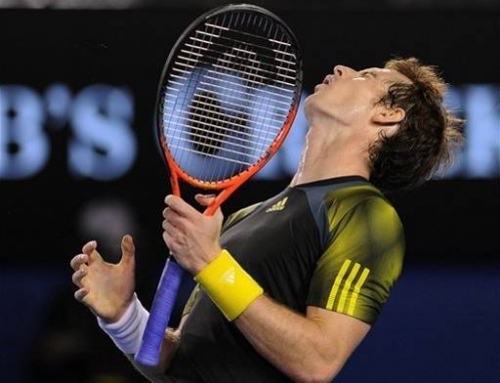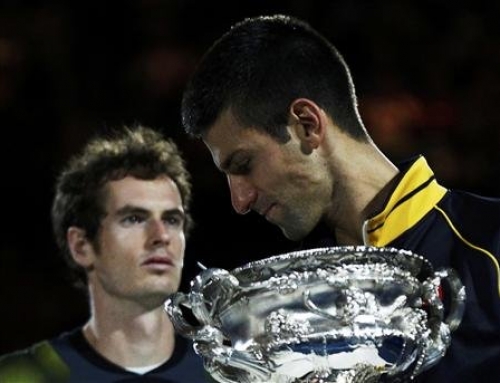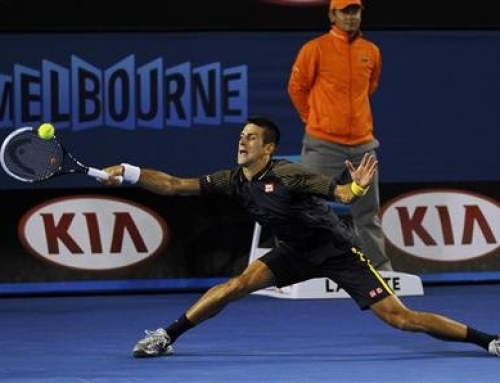 It’s often been said that Bernard Tomic plays like no one else. If comparisons are made to active players, it’s often to Andy Murray who often uses change of pace, but even he plays a bit differently to Tomic, or to Alexandr Dolgopolov. Well, wouldn’t you know it, the draw happened to put Tomic and Dolgopolov to meet in the third round.
It’s often been said that Bernard Tomic plays like no one else. If comparisons are made to active players, it’s often to Andy Murray who often uses change of pace, but even he plays a bit differently to Tomic, or to Alexandr Dolgopolov. Well, wouldn’t you know it, the draw happened to put Tomic and Dolgopolov to meet in the third round.
This was no easy task, by any means. Dolgopolov played in the finals of Brisbane a little over a week ago and had some groin issues. It wasn’t clear he was completely healed. When he dropped the first two sets in the first round to a relative unknown, folks speculated that he was perhaps more hurt than expected. Nonetheless, he managed to dig himself out of that hole and win in 5 sets. Dolgopolov found himself in yet another five setter against Tobias Kamke in the second round, but again, won that in five sets.
Tomic’s route was not much better. In the opening round, Tomic had to face a seed–Fernando Verdasco–in one of the hotter days of the Australian Open. Verdasco used his ability to hit hard and create angles to run Tomic ragged. Tomic had chances in the second set to take the set, but failed to do so and found himself in a two set hole. Everyone figured his fitness was still not good enough to handle the big boys, but somehow, he played “possum” and worked his way in the third set with each player holding serve. He then pounced, got a break, and took the third set. It was around this time that Verdasco claimed he had a stomach issue that was affecting his own play. Tomic took the fourth set as well.
At this point, Verdasco realized that he needed to play better if he was going to win, but he had already sacrificed two sets and Tomic was feeling pretty good. The fifth set was much tighter, but Tomic eventually got the break and took the fifth set and escaped.
The second match was a bit better for Tomic. Sam Querrey, who was out much of 2011, was looking pretty good. He wanted to use his serve and his big forehand to dictate points, and took the first set. However, Tomic had begun to cast his spell. His mix of slices and spins began to bother Querrey. Tomic took the next three sets rather comfortably as Querrey struggled to figure out how to his against this guy.
Afterwards, Tomic was asked about his next opponent, Alexandr Dolgopolov. Tomic exclaimed that he hated playing Dolgopolov and he was sure Dolgopolov hated playing him. Dolgopolov had beaten him on three occasions. Twice last year and once the year before. In both meetings last year, Tomic took a close first set before Dolgopolov easily took the following two sets.
Although the two players play somewhat similar games, they are different. Tomic is a lot more cat and mouse. Tomic doesn’t look to dictate with power. He would prefer hitting soft shot after soft shot and if you decide to get aggressive, he might do the same. Say, you hit a big forehand to his forehand corner. He might all of a sudden slap that shot down the line. Even when opportunities might dictate hitting a big shot, he might opt to slice the forehand.
By contrast, Dolgopolov, who also likes to slice off backhand and forehand, is much quicker than Tomic and prefers to use his power at surprising times. When other players might be content to hit a standard rally, Dolgopolov whips an angle crosscourt forehand. He often hits a huge shot when you least expect it. He also had a challenging serve to return.
The two of them combined lead to some of the strangest points you’ll see played all year especially their numerous chip to chip backhand exchanges. Most players would find this meaningless and look for ways to get out of such rallies, but both Dolgopolov and Tomic seemed happy going back and forth. After the initial slice exchange, which always gets an audience laughing nervously wondering who will finally hit something different, the crowd realized that such rallies were going to be commonplace between the two.
Dolgopolov controlled the early going mostly because he was able to use his power and hit to where Tomic wasn’t. He was also able to sneak to net and finish off points. Tomic, whose movement isn’t great, struggled to deal with this, but tried to keep to his strategy. The Ukrainian took the first set 64. He was up a break in the second set as well, but Tomic was able to break back as his strategy was starting to pay off. Dolgopolov was starting to net shots. Tomic’s serve also gave Dolgopolov trouble. Darren Cahill wondered aloud why Dolgopolov didn’t recognize that Tomic likes serving out wide on both ad and deuce court, and that serve bailed Tomic out of lots of points.
Tomic turns out to have a pretty amazing tiebreak record. Most players tend to win as many tiebreaks as they lose, even the very best players. Tomic was aggressive on return, then held his own serve twice, then broke Dologopolov twice, again with aggressive shots he hadn’t used much the entire set, and eventually swept the tiebreak 7 points to love.
In the third set, the two players also swapped breaks and it too headed to a tiebreak, where the first five points went against server with Tomic taking the first point, Dolgopolov taking the next two and Tomic taking the next two. This seemed like a key set that Tomic had to win because Dolgopolov still had a few more weapons than Tomic. Taking this set would give Tomic the momentum. Tomic eventually took this tiebreak as well, 8 points to 6, and we headed to a fourth set.
Despite being down two sets to none, Dolgopolov still looked pretty sharp and was soon up a break of serve. It wasn’t clear whether Tomic wanted to fight for this set or not. When Tomic lost another serve playing sloppy tennis, it was all he could do to quickly lose the fourth set and play the fifth.
In the fifth, Tomic played a bit better, and avoided being broken. The slices and dices were beginning to work as Dolgopolov struggled with errors. Tomic was able to secure an early break, and then, despite challenges, held to win the match in five sets.
Final score: 46, 76, 76, 26, 63.
The first two matches on Rod Laver Arena featured the second and third seeds. Rafael Nadal played Lukas Lacko. Lacko was originally a doubles specialist but has played more singles as of late. He beat Donald Young in the previous round. I had hoped that Lacko would have enough off the ground to bother Nadal. However, Nadal broke Lacko his first service game. Lacko returned the favor, and it seemed the match might be interesting.
It wasn’t. Lacko, who played Nadal last year and lost 2, 2, and 2, did only marginally better. Although Lacko has the ability to hit hard and hit good spots, these matches invariably start with the weaker player looking pretty good in the first set, but the better player winning the rallies nonetheless. Then, as the match goes on, the shots that were landing in during the first set start landing wide or deep. Lacko manage to keep the second set relatively close at 64, but lost the third set at 62. Nadal is looking pretty solid and will face countryman Feliciano Lopez next.
Lopez played marathon man, John Isner, and this too was a marathon. Unlike Nalbandian, Lopez has a pretty good first serve and it won him quite a few points. Isner didn’t seem fully recovered, but he did as he usually does. He fights. Lopez took the first set 63, and Isner took the second set 76. Lopez took the third set 64 and Isner took the fourth set 76. However, Isner went away quickly in the fifth set and lost 61. It’s been a challenge for Isner to back up a big five setter and play well the next round. Although Isner lost, at least he pushed it to five sets.
Tomas Berdych has been flying under the radar. He’s been playing good tennis, but no one has seemed to notice. In the third round, he faced tall Kevin Anderson who may be the best moving of the men at that height. That’s a pretty small category that includes Karlovic, Isner, and himself. He is far more mobile than either Isner or Karlovic, and might be at the level of Querrey or so. Berdych and Anderson play similarly but Berdych seems just a touch better. The two went to tiebreak the first two sets and Berdych won both. Commentators felt Anderson would fold pretty quickly and he did in a 61 final set as Berdych delivered more confident shots.
Berdych will play Nicolas Almagro. Almagro played an erratic Stan Wawrinka. The Spaniard is not known as a hard court player, but Wawrinka also prefers the clay (though he did win Chennai on hard courts). Almagro won in straight sets with the Swiss number 2 not playing all that well.
The Swiss number 1, Roger Federer, was pitted against Ivo Karlovic. Federer claims to like these matches. Invariably Karlovic creates a lot of anxiety for most players. He has a huge serve and so mostly you are seeing aces whiz by. Karlovic has a pretty good forehand, and he is quite a volleyer for a guy his height. He mostly only has a slice on the backhand, but he uses it well, and brings people to net where he often does quite well against them. With a huge wingspan, it’s hard to get a ball by him or above him. Then, on your own serve, you feel pressure to hold. Karlovic is no slouch and can use that forehand to apply a bit of pressure, so you feel that every opportunity you have must be taken and not missed. Nadal generally has no problems with this, but most everyone else does. And thus, Karlovic wins because he’s built a strategy that hides his limitations (non-aggressive backhand and lack of footspeed).
When Roger plays Karlovic, he actually gets pretty close to the baseline and hopes to cut off angles. It usually takes him about a set before he can start to read the Karlovic serve. His goal is usually to slice it short with the backhand or up-the-line if he can manage it, and get the ball in play.
The first set invariably went to a tiebreak. There’s still a lot of pressure to win all the points on your own serve. Federer eventually lost one of his and the prospect of losing the first set loomed large. Who knows what would happen if he dropped a set? Perhaps Karlovic gets more confident and the second set also goes to a tiebreak?
Karlovic, at match point, found himself at net. Federer took a swipe at a pass. Karlovic drop volleyed the shot. But it wasn’t as short as he hoped. Federer managed to barely reach there, then play a bizarre shot. He tried to lob over Karlovic. The shot actually worked as Karlovic mishit the overhead, and Federer saved match point. Federer was able to take the first set 8 points to 6 in a tiebreak.
The second set more or less went the same as the first as both players held serve game after game. However, by the end of the second set, Federer was starting to return a lot more serves and force Karlovic to play more points which invariably favors Federer. Federer secured the break and won the set 75. The third set was much nicer to Federer as he got an early break. Although he had chances in later games to perhaps secure a second break, he mostly rode that one break to the victory. Final score: 76 75 63.
Kohlschreiber had a relatively easy straight sets win over Falla, and del Potro had an even easier win over Yen-Hsun Lu. The two will meet in the fourth round.






![[Aussie Open Final] Can Andy Murray beat Novak Djokovic?](https://www.essentialtennis.com/wp-content/uploads/2013/01/20130126andy-500x383.jpg)
![[Day 13, Aussie Open] Bryan brothers win 13th Slam with Aussie doubles title, Kyrgios wins boys title](https://www.essentialtennis.com/wp-content/uploads/2013/01/20130125bryan-500x383.jpg)